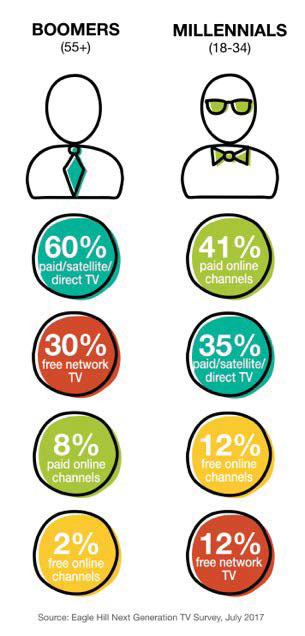Viewer Preferences Straddle Generations
ARLINGTON, VA.—Perhaps the biggest challenge facing the TV industry is meeting the rapidly changing preferences of viewers. In fact, research reveals that shifting consumer preference trends are moving even faster than expected. More specifically, there seems to be widening chasm when it comes to consumer preferences on viewing convenience versus quality.
This “quality versus convenience” chasm presents a key strategic question for TV executives—how and where does a company invest when trying to meet the needs of myriad consumer segments with vastly different viewing habits and preferences?

Fig. 1: According to Eagle Hill Consulting’s media survey, the majority of Baby Boomers get their television via traditional multichannel video program distributor while Millennials prefer OTT .
TRADITIONAL VERSUS NEW
To understand the preferences issue at a deeper level, Eagle Hill Consulting surveyed more than 1,000 adults across the U.S. on their TV viewing trends and preferences. Some of what we learned was expected. Some of the findings were surprising.
Let’s look at age.
Already, Millennials have surpassed Baby Boomers as the nation’s largest living generation, with those ages 18-34 numbering 75.4 million in 2015 compared to 74.9 million Baby Boomers (ages 51-69). We found that most Baby Boomers still prefer a “traditional,” quality-focused viewing experience. We also found that Millennials are more likely to value convenience over quality. In fact, convenience is four times more important for viewers 18-34 than for those 55 and older. No surprise, right?
But what happens when you factor in race?
Get the TV Tech Newsletter
The professional video industry's #1 source for news, trends and product and tech information. Sign up below.
We were surprised to find that when looking across all age groups, nearly twice as many nonwhite respondents (36 percent vs. 20 percent) say they prioritize convenience over quality. That has major implications for TV technology strategy because the nation’s population is becoming increasingly diverse. Pew Research predicts that by mid-century, the United States will have no racial or ethnic majority group. Instead, we will have a “minority majority” with whites making up less than half of the population. For this growing non-white population, a focus on convenience clearly is an important factor as executives develop their technology strategy.
Our research also uncovered that for nearly 90 percent of all respondents, home remains the most popular place to watch TV. Compared to their parents, Millennials are nearly 20 times more likely to watch TV on the go. Millennials are also quite comfortable “cutting the cord,” with more than half (53 percent) reporting they most frequently watch online channels. Just 10 percent of those 55+ say online viewing is their top TV service.
A DELICATE BALANCE
So why does all this matter? Nielsen research indicates that average time per day watching video keeps increasing while traditional TV consumption continues to decrease. That means that companies must make tough decisions on the best technology investments when serving multiple audiences with diverse habits and preferences. Much of the technology investment in recent years has been directed toward the quality side of the equation.
The industry has been moving to Ultra-HD, high dynamic range, wide color gamut, high frame rate, and immersive audio—all serving to increase the quality of content. However, it’s a delicate balance between investments in video quality versus the expense of convenience. We must retain an equal focus on serving viewers where they want to consume content, often in environments where these quality enhancements just don’t matter. Companies that are thoughtful and strategic will find a way to straddle both—making investments that will pay off now and as trends evolve and accelerate.
Here are a few approaches companies can consider as they try to straddle the viewing quality and convenience chasm:
Get nimble and get moving. You don’t need all the answers to act and you don’t have to start with a big bang. No matter where you are today, begin by getting your house in order: examine current workflows. Weed out duplicative processes. Find opportunities to simplify, consolidate and virtualize your infrastructure. Making your operations more efficient means you have more resources to devote to content—and position your organization for growth.
Shift your business model. Still thinking of your organization as a broadcast, online and/or wholesaling business? Truth is, you’re in the content business. Your organizational culture needs to evolve to reflect that. Encourage people to think in new ways, embrace and manage change, ask tough questions and tackle complex problems. How would you build your business today if you were to start from scratch?
Think about how you’re serving segments. Content is no longer a mass-market business. With diverse audiences, growing competition and an abundance of brands, content looks more like a consumer business. As you shape your organization, look to consumer industries for lessons in understanding and building relationships with customers. One possibility: appointing a Chief Segment Officer responsible for analyzing each segment’s needs and helping to craft the kind of viewer experience that delivers both quality and convenience.
Twenty years down the road, there will be new technology disruptors we don’t even anticipate today that will create new chasms. But for today, TV executives can take proactive measures so they aren’t swallowed up by today’s wide gulf on viewers’ convenience and quality preferences.
John McCoskey is Industry Lead Executive-Communications, Media & Technology at Eagle Hill Consulting.
